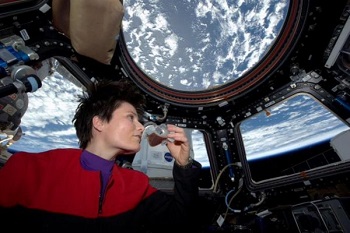The fondest wish of Italian astronaut, Samantha Cristoretti, was to have a cup of espresso during her sojourn on the International Space Station. An Italian made espresso machine arrived on the most recent supply ship and now there is espresso in space. The RT website reports on how real coffee hits space.
Last month, the Dragon spacecraft, built and operated by SpaceX, delivered the first-ever space espresso machine, built by Italian coffee company Lavazza and Italian aerospace firm Argotec, to the space station, along with special, zero-gravity cups. Prior to the coffee machine’s long-awaited arrival, the only option aboard the orbiting laboratory was powdered instant coffee. The cups, co-designed by International Space Station researcher Mark Weislogel and astronaut Don Pettit, are peculiarly shaped so that a sharp corner makes the liquid inside stream toward a person’s mouth when they drink from it.
At last there is espresso in space. If there is an Irish astronaut will Irish coffee be next?
Espresso in Space
The Nasa.gov website reports that the espresso machine in space is about the size of one on earth.
ISSpresso is not much larger than a typical Earth-based espresso machine, and produces espresso, broth or tea.
Making espresso in space is fantastic but how about drinking it from a cup?
The Zero Gravity Coffee Cup
Liquids act strangely in zero gravity. They float around like blobs. NASA Science explains the zero gravity coffee cup.
High above our planet in the realm of satellites and space stations, the familiar rules of Earth do not apply. The midday sky is as black as night. There is no up and no down. Dropped objects do not fall, and hot air does not rise.
Of all the strange things that happen up there, however, it is possible that the strangest happens to coffee.
Physics professor Mark Weislogel of Portland State University has given a lot of thought to coffee (and other fluids) in space, and he describes what happens:
“For starters,” he says, “it would be a chore just getting the coffee into the cup. Absent the pull of gravity, pouring liquids can be very tricky.”
[BUT] If two solid surfaces meet at a narrow-enough angle, fluids in microgravity naturally flow along the join-no pumping required. This capillary effect could be used to guide all kinds of fluids through spacecraft, from cryogenic fuel to recycled waste water. The phenomenon is difficult to study on Earth, where it is damped by gravity, yet on the space station large scale corner flows are easy to create and observe.
Basically, one side of the cup has a sharp interior corner. In the microgravity environment of the space station, capillary forces send fluid flowing along the channel right into the lips of the drinker.
“As you sip, more fluid keeps coming, and you can enjoy your coffee in a weightless environment – clear down to the last drop,” says Pettit. “This may well be what future space colonists use when they want to have a celebration.”
The photos are of the zero gravity coffee up uniquely designed for drinking espresso in space and the zero gravity espresso maker.

